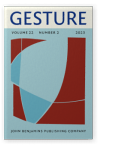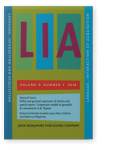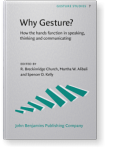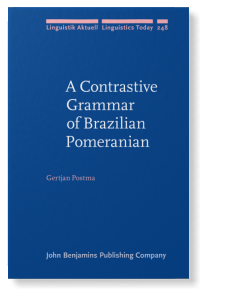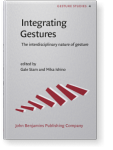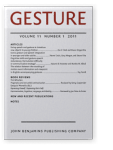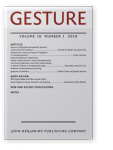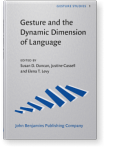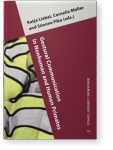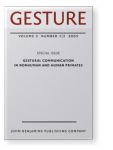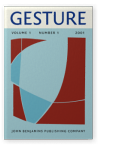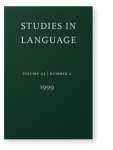Sotaro Kita
List of John Benjamins publications for which Sotaro Kita plays a role.
Journal
2025 Infants can create iconic gestures during natural interactions with caregivers Gesture 22:3, pp. 288–324 | Article
Adults across cultures produce iconic gestures, but little is known about the emergence of iconic gesturing in infants. This study aimed to identify plausible instances of infants’ earliest iconic gestures to learn more about their form and the interactional contexts in which they emerge. We… read more
2018 Gestural depiction of motion events in narrative increases symbolic distance with age Verbal and gestural expression of motion and spatial events / L’expression verbale et gestuelle du mouvement et de l’espace: New evidence from different age groups and linguistic environments / nouveaux arguments en provenance de différents groupes d’âge et de différents environnements linguistiques, Fibigerová, Kateřina, Jean-Marc Colletta and Michèle Guidetti (eds.), pp. 40–68 | Article
We examined gesture representation of motion events in narratives produced by three- and nine-year-olds, and adults. Two aspects of gestural depiction were analysed: how protagonists were depicted, and how gesture space was used. We found that older groups were more likely to express… read more
2017 Chapter 2. Representational gestures help speakers package information for speaking Why Gesture?: How the hands function in speaking, thinking and communicating, Church, Ruth Breckinridge, Martha W. Alibali and Spencer D. Kelly (eds.), pp. 15–37 | Chapter
Abstract
The Information Packaging Hypothesis (IPH; Kita, 2000) holds that gesture helps speakers package information into units appropriate for verbalization. When information packaging is more difficult, speakers produce more gestures. Further, manipulations of gesture can affect… read more
2014 Authors’ Preface Sign Language & Linguistics 17:2, pp. 213–214 | Article
2014 Authors’ Afterword Sign Language & Linguistics 17:2, pp. 239–240 | Article
2014 The non-linguistic status of the Symmetry Condition in signed languages: Evidence from a comparison of signs and speech-accompanying representational gestures Sign Language & Linguistics 17:2, pp. 215–238 | Article
Since Battison (1978), it has been noted in many signed languages that the Symmetry Condition constrains the form of two-handed signs in which two hands move independently. The Condition states that the form features (e.g., the handshapes and movements) of the two hands are ‘symmetrical’. The… read more
2011 Chapter 20. Microgenesis of gestures during mental rotation tasks recapitulates ontogenesis Integrating Gestures: The interdisciplinary nature of gesture, Stam, Gale and Mika Ishino (eds.), pp. 267–276 | Chapter
People spontaneously produce gestures when they solve problems or explain their solutions to a problem. In this chapter, we will review and discuss evidence on the role of representational gestures in problem solving. The focus will be on our recent experiments (Chu & Kita, 2008), in which we used… read more
2011 Iconic gesture and speech integration in younger and older adults Gesture 11:1, pp. 24–39 | Article
This study investigated the impact of age on iconic gesture and speech integration. The performance of a group of older adults (60–76 years) and a group of younger adults (22–30 years) were compared on a task which required the comprehension of information presented in 3 different conditions:… read more
2010 Gesture highlights perceptually present information for speakers Gesture 10:1, pp. 3–28 | Article
Why do speakers produce gestures? This study tests the hypothesis that gesture facilitates the conceptual planning of speaking, and in particular, gesture promotes thinking about perceptually present information. This view implies that, when gesture is prohibited, people should be less likely to… read more
2007 5 How does Spoken Language Shape Iconic Gestures? Gesture and the Dynamic Dimension of Language: Essays in honor of David McNeill, Duncan, Susan D., Justine Cassell and Elena T. Levy (eds.), pp. 67–74 | Chapter
2007 How does linguistic framing of events influence co-speech gestures? Insights from crosslinguistic variations and similarities Gestural Communication in Nonhuman and Human Primates, Liebal, Katja, Cornelia Müller and Simone Pika (eds.), pp. 199–218 | Article
What are the relations between linguistic encoding and gestural representations of events during online speaking? The few studies that have been conducted on this topic have yielded somewhat incompatible results with regard to whether and how gestural representations of events change with… read more
2005 How does linguistic framing of events influence co-speech gestures? Insights from crosslinguistic variations and similarities Gestural Communication in Nonhuman and Human Primates, Liebal, Katja, Cornelia Müller and Simone Pika (eds.), pp. 219–240 | Article
What are the relations between linguistic encoding and gestural representations of events during online speaking? The few studies that have been conducted on this topic have yielded somewhat incompatible results with regard to whether and how gestural representations of events change with… read more
2001 Pointing left in Ghana: How a taboo on the use of the left hand influences gestural practice Gesture 1:1, pp. 73–95 | Article
In Ghana, many peolple consider pointing by the left hand to be a taboo. We investigated consequences of this taboo on the Ghanaian gestural practice by observing gestures produced during naturalistic situations of giving route directions. First, there is a politeness convention to place the left… read more
1999 Japanese Enter/Exit Verbs Without Motion Semantics Studies in Language 23:2, pp. 307–330 | Article
The semantics of English and Japanese Enter/Exit verbs is compared. It is argued that the temporal schema encoded in the Japanese verbs hairu 'enter' and deru 'exit' is discrete change of state. For example, hairu encodes at one point in time, something is not inside, and at a later point in time… read more
